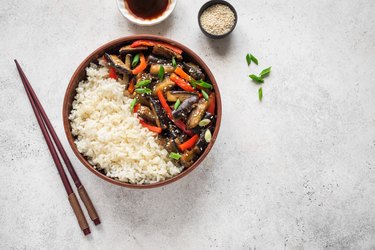
Rice is a starchy grain that can contribute a significant amount of carbs to your diet, depending on how much of it you eat every day. If you need to keep track of how many carbs you're eating for either medical or dietary reasons, here's how to count the carbohydrates in rice.
Video of the Day
Video of the Day
Carbs in 1/2 Cup Rice
The American Heart Association (AHA) defines one serving of rice as 1/2 cup of cooked rice. The AHA notes that serving sizes are not to be confused with portion sizes. While serving size is the recommended serving amount defined by the manufacturer and listed on the nutrition labels of foods, portion size is how much of it you choose to eat and is entirely under your control.
The number of carbs in 1/2 cup of rice is similar across the different varieties of rice. There are 22.25 grams of carbs in 1/2 cup of white rice, 22.9 grams of carbs in 1/2 cup of brown rice and 17.5 grams of carbs in 1/2 cup of wild rice. These carb values include the carbs from sugar, starch and fiber.
Counting Carbs With Diabetes
If you have diabetes, you need to be mindful of how many carbs you're eating per day, and carb counting is a helpful technique that helps ensure you're not eating too many, according to the U.S. National Library of Medicine. The goal is not to cut out carbs from your diet but to eat a regular amount of carbs throughout the day to keep your blood sugar level steady.
In order to count carbs, the American Diabetes Association (ADA) suggests looking at food labels. The two things to look for are serving size and the total number of carbs per serving. If you plan to eat more than one serving, you will have to multiply the total number of carbs per serving by the number of servings you eat. This calculation technique applies to all carbs; you could use it to count the carbs in pasta, for example.
For those who take insulin, the U.S. National Library of Medicine notes that counting carbs can also help you determine the exact dose of insulin you need with your meals. If, for example, you're eating some carbs in pasta along with the carbs in your rice, this technique can help you estimate your total carb intake and help you calculate how much insulin you require.
The ADA also recommends working with a nutritionist or certified diabetes educator (CDE) to help you manage your blood sugar.
Adjusted Rice Intake for Diabetes
According to the U.S. National Library of Medicine, most people with diabetes should eat no more than 200 grams of carbs per day. The daily recommended amount for most adults is 135 grams of carbs per day, although pregnant women may require over 175 grams of carbs per day.
The U.S. National Library of Medicine defines one serving as an amount of food that contains 15 grams of carbs for people who are carb counting. By this definition, one serving of rice is around 1/3 cup of cooked long-grain rice or 1/4 cup of cooked short-grain rice.
Read more: List of Good Carbohydrates to Eat
Carb counting means adding up all the carbs you eat in a day. So you would have to add the carbohydrates in the rice you eat at lunch with the carbs in the pasta you eat at dinner for example, as well as all the other carbs you eat in a day, whether they're from sugar, starch or fiber.
- Harvard T.H. Chan School of Public Health: “Rice”
- American Heart Association: “What Is a Serving?”
- American Heart Association: “Portion Size Versus Serving Size”
- USDA: “Rice, White, Long-Grain, Regular, Enriched, Cooked”
- USDA: “Rice, Brown, Medium-Grain, Cooked”
- USDA: “Wild Rice, Cooked”
- U.S. National Library of Medicine: “Counting Carbohydrates”
- American Diabetes Association: “Get Smart on Carb Counting”
Was this article helpful?
150 Characters Max
0/150
Thank you for sharing!
Thank you for your feedback!